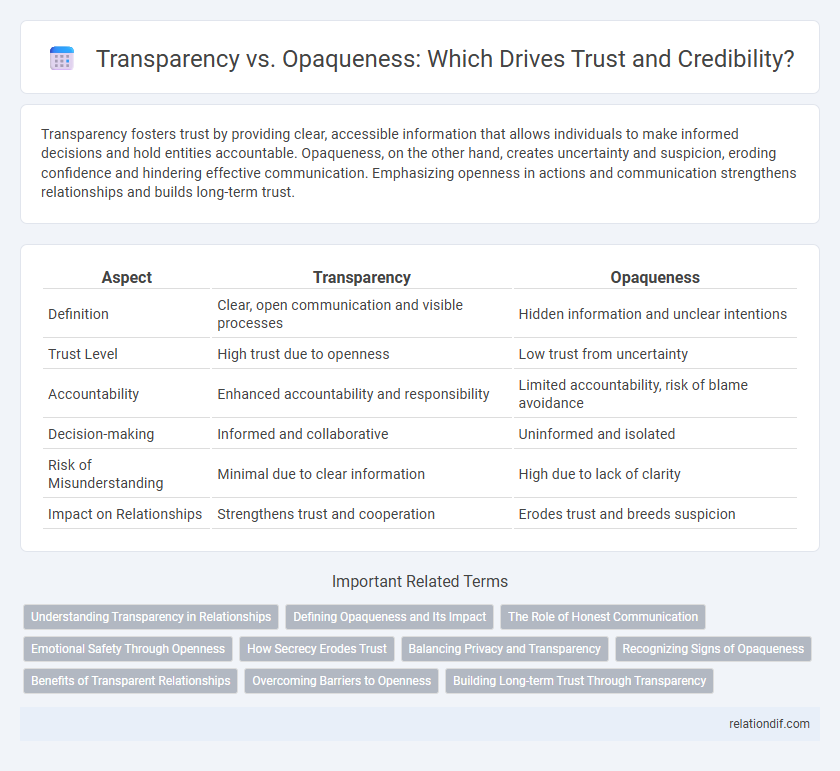Transparency fosters trust by providing clear, accessible information that allows individuals to make informed decisions and hold entities accountable. Opaqueness, on the other hand, creates uncertainty and suspicion, eroding confidence and hindering effective communication. Emphasizing openness in actions and communication strengthens relationships and builds long-term trust.
Table of Comparison
| Aspect | Transparency | Opaqueness |
|---|---|---|
| Definition | Clear, open communication and visible processes | Hidden information and unclear intentions |
| Trust Level | High trust due to openness | Low trust from uncertainty |
| Accountability | Enhanced accountability and responsibility | Limited accountability, risk of blame avoidance |
| Decision-making | Informed and collaborative | Uninformed and isolated |
| Risk of Misunderstanding | Minimal due to clear information | High due to lack of clarity |
| Impact on Relationships | Strengthens trust and cooperation | Erodes trust and breeds suspicion |
Understanding Transparency in Relationships
Understanding transparency in relationships fosters trust by promoting open communication, honesty, and clarity of intentions. Transparency reduces misunderstandings and builds emotional safety, enabling partners to navigate conflicts effectively and strengthen their connection. Emphasizing genuine openness over opaqueness creates a foundation where mutual respect and reliability thrive.
Defining Opaqueness and Its Impact
Opaqueness in organizational practices refers to the lack of clarity and withholding of information from stakeholders, creating barriers to understanding decisions and actions. This lack of transparency erodes trust by fostering suspicion and uncertainty, which can lead to decreased employee engagement and customer loyalty. Organizations that maintain opaqueness risk reputational damage and reduced stakeholder confidence, undermining long-term success.
The Role of Honest Communication
Honest communication serves as the foundation of transparency, fostering trust by openly sharing information, intentions, and motivations without concealment. Transparency reduces uncertainty and builds credibility by allowing stakeholders to verify facts and understand decision-making processes. In contrast, opaqueness breeds suspicion and undermines relationships, highlighting the critical role of candid dialogue in cultivating genuine trust.
Emotional Safety Through Openness
Transparency fosters emotional safety by creating an environment where individuals feel secure expressing their thoughts and feelings without fear of judgment. Openness reduces uncertainty and builds trust by encouraging honest communication and mutual understanding. Emotional safety through transparency enhances collaboration and strengthens relationships by promoting authenticity and accountability.
How Secrecy Erodes Trust
Secrecy creates barriers that prevent open communication, leading to suspicion and doubt among stakeholders. When information is withheld, individuals and organizations struggle to verify intentions or actions, weakening relational confidence. Consistent transparency fosters trust by promoting accountability and reducing uncertainties that secrecy typically amplifies.
Balancing Privacy and Transparency
Achieving a balance between privacy and transparency is essential for fostering trust in digital interactions. Organizations must implement clear data governance policies that ensure transparency about data usage while protecting sensitive personal information. Transparent communication paired with robust privacy measures empowers users to make informed decisions and reinforces confidence in institutional integrity.
Recognizing Signs of Opaqueness
Recognizing signs of opaqueness involves identifying vague communication, inconsistent information, and a lack of accountability within organizations or individuals. Opaqueness often manifests through withholding critical details, avoiding direct answers, and obscuring decision-making processes. These behaviors hinder trust-building and compromise transparency essential for authentic relationships.
Benefits of Transparent Relationships
Transparent relationships foster trust by promoting honesty and clear communication, which enhances mutual understanding and reduces misunderstandings. Openness in sharing information builds accountability, making parties more reliable and dependable. This clarity strengthens collaboration, driving better decision-making and long-term success.
Overcoming Barriers to Openness
Overcoming barriers to openness requires organizations to implement clear communication strategies and provide consistent access to relevant information, fostering trust with stakeholders. Emphasizing transparency in decision-making processes and performance metrics helps dismantle misconceptions and build credibility. Maintaining accountability and encouraging feedback loops reinforces a culture of openness, reducing resistance caused by opaqueness.
Building Long-term Trust Through Transparency
Building long-term trust requires consistent transparency, where organizations openly share information about their processes, intentions, and decisions. Transparency fosters accountability and reduces uncertainty, encouraging stakeholders to feel confident in the integrity and reliability of the entity. In contrast, opaqueness breeds suspicion and hinders relationship development, ultimately weakening trust over time.
Transparency vs Opaqueness Infographic

 relationdif.com
relationdif.com